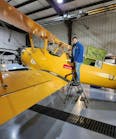SENER Delivers the First Helicopter to the Spanish Navy of the AB212 Life Extension Program
Madrid (Spain), 21 December 2015 – The SENER engineering and technology group, in a joint venture with INAER, the main helicopters operator in Spain, has delivered the first Agusta Bell 212 (AB212) helicopter to the Directorate-General of Armament and Material (DGAM) of the Spanish Ministry of Defense, after completing the first phase of its modernization that will extend the operational life of seven AB212 helicopters by at least another 15 years.
The SENER-INAER joint venture is responsible for the life extension program by incorporating advancements in equipment and avionics. In the joint venture, SENER has led the design, engineering and integration works, while INAER has led the installation and certification works.
According to the head of the SENER-INAER joint venture, the SENER engineer Fernando Quintana, “the modernization of the AB212 is an ambitious program, the first of its kind in the Spanish aeronautical industry, which will significantly improve the performance of these helicopters by incorporating new capacities such as radar, a night vision system, protection and self-defense systems, etc. The AB212 are helicopters ready to operate effectively in ever more demanding national and international contexts. This initiative has implied a much lower cost for the Spanish Navy than that of replacing them with new models with similar capacities.”
In this sense, Jorge Arnás, INAER’s Director of Desing and Integration, highlighted that “this ambitious project shows once again INAER’s compromise with the Armed Forces that, in this occasion, has been put at the service of the Spanish Ministry of Defense for the recondition of the AB212 helicopters. This collaboration guarantees the fine tuning of the aircrafts under the most demanding quality standards, extending their operational life and their capability for providing service with total security.”
This life extension program, as well as completely replacing the electrical system and the analogue cockpit for a completely digital one, involves the incorporation of state-of-the-art mission systems such as EFIS, EO/IR radar, Automatic Identification System (AIS), GPS navigation system, TAWS, Tactical Mission Controller (TMC), cargo crane, modifications to the auxiliary fuel tanks, a missile approach warning system (MAWS), a ballistic protection system in the flight and passenger cabin, armored and anti-crash seats for the crew, and defense weapon systems. It also includes the addition of plug-in technology that will allow the helicopters to be quickly reconfigured for new missions.
This way, the helicopters will be able to operate without restriction in controlled military and civilian airspaces, in accordance with the requirement of new regulations, as well as giving them self-protection and defense systems that will allow them to be deployed in multinational missions with a low-medium threat level.
About SENER
SENER is a private engineering and technology group founded in 1956. It seeks to offer its clients the most advanced technological solutions and enjoys international recognition thanks to its independence and its commitment to innovation and quality. SENER has a workforce of near 6,000 professionals distributed across its offices in Algeria, Argentina, Brazil, South Korea, Chile, China, Colombia, the United Arab Emirates, Spain, the United States, India, Japan, Mexico, Poland, Portugal and the United Kingdom. The group’s turnover exceeds 1.305 billion Euros (2014 data).
SENER engages in the specific activities of Engineering and Construction. It also has industrial holdings in companies involved in Aeronautics, as well as in the field of Energy and Environment. In the area of Engineering and Construction, SENER has become a world leader in Aerospace, Infrastructures and Transport, Power, Oil & Gas, and Marine.
In 2016, SENER will be celebrating its 60th anniversary with a long track record of projects, international experience and a team comprised of thousands of professionals who are the co-creators of the innovations that have marked its past and will shape its future.

